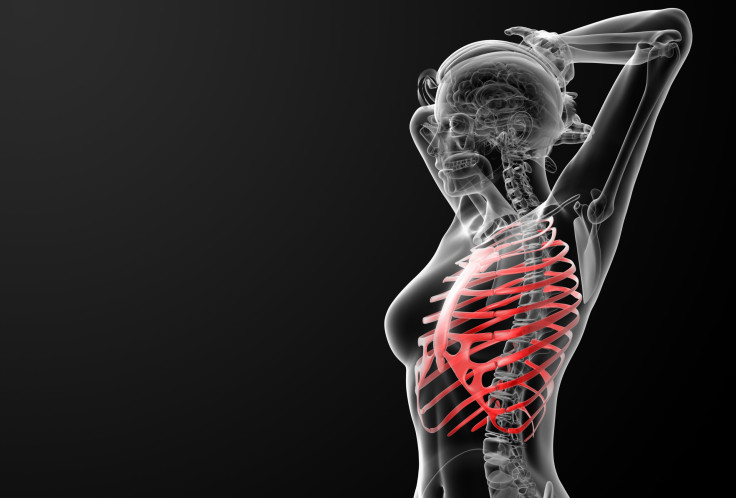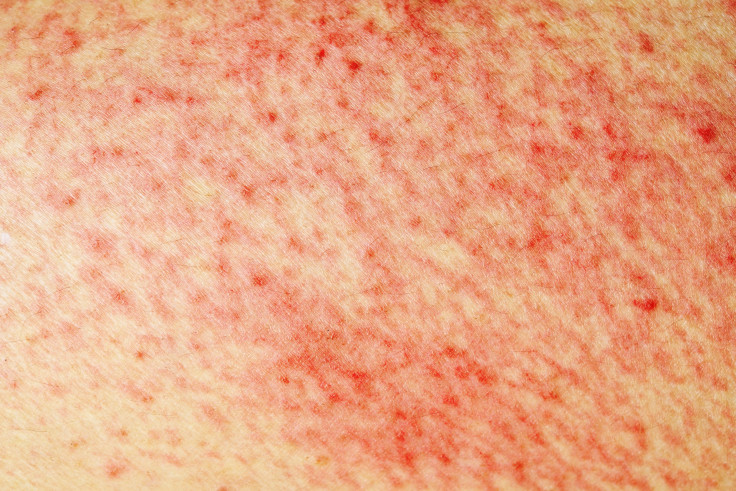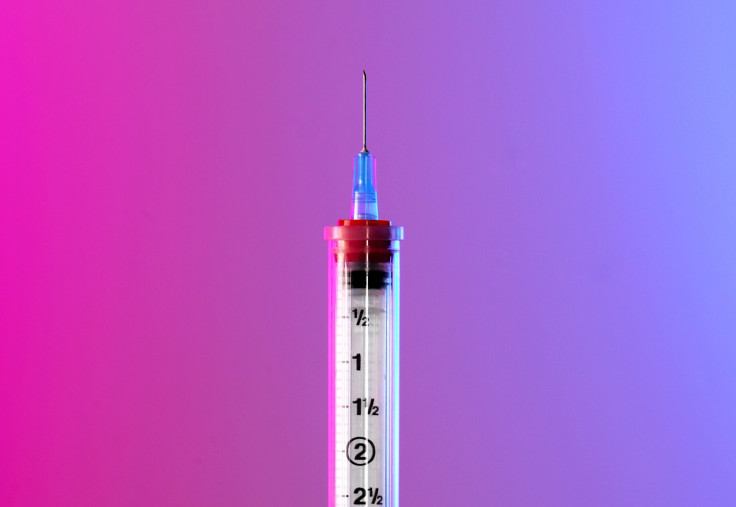Stress-Induced Shingles: How The 'Dragon In My Ribcage' Led To A Painful And Unexpected Diagnosis

“There is a dragon living inside my ribcage,” I explained to my mother late one Thursday night. I was curled on the couch wincing as another bout of unrelenting pain flashed through my right side. “When it wakes, sometimes it breathes fire and other times it tries to claw its way out of my chest.”
I was desperately trying to make her understand how I felt. She squeezed my hand and called me "sweetie." There was nothing she could do but comfort me and wait for it to pass. I was going on the second week of a rare and unexpected diagnosis. Earlier in the week, I was at work sitting at my desk when another wave of pain shot through my back and wrapped around my chest. I hunched over with tears glazed over my eyes, my fist clenched. It was everything I could do not to slam it into the keyboard.
The dragon roared.
I finally gave up and called my mom crying in the hallway. My entire right arm began to tingle numb and uncomfortably to the slightest touch. She told me to get on the earliest train home; we had to go to the emergency room. "I have a rib injury," I told my manager who encouraged me to go home, get some rest, and feel better.
It was just an intercostal tear, I told myself—the muscles between my ribs must have torn during my nine-mile hill workout. That’s when the pain set in, at least. I needed physical therapy and maybe a muscle relaxer, at most.
But I was wrong, very wrong. I sat shyly behind pulled hospital curtains with my shirt off. The red rash that showed up shortly after the initial post-run pain had spread like a streak of wildfire from the middle of my spine to beneath my right breast. This is bad, I thought as I listened to a whimpering girl with a neck brace in the curtain next to me. My mom stood with a smile meant to calm me.
Diagnosing The Dragon
The physician’s assistant walked in first, as is the routine for most hospitals now. One look, one explanation of the pain I had endured for nearly two weeks was all it took for him.
“You’re the youngest case I’ve ever seen,” he said. “You have shingles.”
Yes, you know it as the disease old people get when their immune systems are so low it leaves them weak and vulnerable enough to reactivate the virus. If you’ve ever had the chickenpox as a child, within your body lies the dormant varicella-zoster virus, waiting for the right moment to awaken within the nerve tissue near your spinal cord and brain. Nearly one out of three people in America will develop shingles at some point in their life, and less than half of them are younger than 60 years old, according to the Centers for Disease Control and Prevention.
A doctor saw me next. He was much older than the PA and stepped in close, his face within inches of my chest. He scratched his beard and mumbled, "Yes, certainly the youngest" and left. A new PA came in to examine me. "They’re getting younger and younger," she said, shaking her head. A nurse followed in shortly after who told me I had pretty eyes. That’s because I have sick eyes, I recalled my grandma saying—glossy, bright blue, and full of worry. But instead I felt like a freak show, a leper, an oddity. Nothing in my life compared to the pain, which the PAs and nurse seemed to understand.
"People cry," the nurse told me. I nodded solemnly. Yes, I know, I thought. I know why they cry.
The first PA returned with a slip to stay home from work. He explained how important rest was and wrote four prescriptions, an antiviral, an anti-inflammatory, and two different pain medications. He told me I needed to follow up with a doctor when my medications were done, and reassured me I wasn’t contagious. Only people who never had the chickenpox or the vaccination were at risk if they touched my ribcage because they had no immunity to it. But they wouldn’t even develop shingles, just the chickenpox. Those who already have the virus, whether they contracted it from a childhood playmate or a sterile needle, are susceptible to having it awaken within them.
I asked him why this had happened to me: a 25-year-old, who was in otherwise peak health. I barely even catch a cold. "Stress—a lot of stress," he said. When you’re stressed, your immune system drops to dangerously low levels. The stress hormone cortisol floods your body and wreaks havoc on everything from organs to emotions. Upon reflection, I realized I had always stacked my schedule with a child-like invincibility. Now, I was finally paying for it.

Unraveling Mother Nature’s Booster Shot
I may not be an anomaly for long. Through my fear-fueled research binges, I came across a study published in 1965 by Dr. Robert Edgar Hope-Simpson, the man who spent 18 years proving the chickenpox virus was able to reactivate itself into a new and more dangerous form: shingles. But it’s what he also discovered that we may all find more pertinent to our lives today: the “new hypothesis.” It revealed that those who were repeatedly exposed to chickenpox — health care workers and family members with young children — were less prone to reactivate the virus.
Each time you’re exposed to the chickenpox virus after you've initially had it, it works as a natural booster shot and drops your risk of reactivating shingles later in life. But in 1995 a chickenpox vaccine was licensed to America, and the incidence of chickenpox decreased dramatically. Pediatricians began to regularly administer the vaccine to any 1-year-old child born after 1995 or within the year. By 2006, the CDC began recommending children between the ages of 4 and 6 years old receive a booster dose, because a single immunization fades over time.
Those children who were born before the vaccine’s introduction, myself included, were not exposed to as many kids with chickenpox running around the neighborhood because they were already vaccinated. They were protected. A vaccine is, after all, a dead form of the virus sent into your system to stimulate antibodies and provide immunity against a specific disease.
Kids that were vaccinated once as an infant and then later on as grown children would be equivalent to when I naturally contracted the chickenpox and was then later on exposed to younger children who also naturally contracted chickenpox — Mother Nature's natural booster shot. But my age mates and I didn’t have the extra boost of exposure that helped everyone else’s immune systems born before us. Those kids, now adults, are the 25- to 30-year-olds living at risk today. And there I was, sitting on the cusp, ripe with susceptibility.
“Reports are beginning to circulate that the frequency of shingles is now higher,” said Dr. Richard Whitley, president of the Infectious Diseases Society of America, who explained the increase is so new experts are still tracking trends. “We are going to see cases of shingles in younger and younger people because there’s less chickenpox in the population now.”
While doctors took into account the economic losses resulting from parents taking off from work to care of their sick kids, Whitley says they didn’t foresee a whole generation missing out on chickenpox’s natural immunity cycle. In the last 18 years, the annual rate of shingles has increased by 39 percent, while the rate of chickenpox has dropped by 90 percent, according to the CDC.
Why were doctors unable to predict the future pain of the unprotected? Because medicine is based on science and science is a game of trial-and-error called the “Scientific Method.” Even seemingly benign and beneficial medical innovations can produce unintended consequences. I was simply a 20-year-old side effect in the making.

Patience: A Panacea for Pain
It’s been five weeks, and the pain still sits inside of me. It may have been manageable if I wasn’t forced to adapt to a sedentary lifestyle for the first month. I couldn’t do anything that broke a sweat, raised my body temperature, or put any type of stress on my body and mind. But running had always been my stress reliever, and without it I was locked in a catch 22. I ran almost every day of the week and lived like that for more than 10 years, biting back tears with the stubborn fervor of any young athlete, through fractures, sprains, strains, tears, stitches, and pulls. Yet, still, nothing could compare to this pain.
I was experiencing post-herpetic neuralgia (PHN), which can last anywhere from weeks to lingering years. It’s the pain left behind even after the rash disappears. Approximately 13 percent of people 60 years of age and older will develop PHN, but it's rare for anyone younger than 40 years old. It quickly became clear to me the human body was not designed to handle this type of pain for this long.
When the virus travels down the nerves and reaches the sensory root, the pain becomes nearly debilitating, and it took my breath away on a daily basis. Many don’t realize there's a link between suicide and shingles. People have taken their own lives from the torment, making it the most common cause of pain-related suicide among patients in the United States.
“Post-herpetic neuralgia continues to be one of the most painful, acute, and chronic conditions to afflict mankind,” according to Dr. John Nelson, a physician who specializes in pain management.
As weeks passed by, the dragon started to quiet down inside its cage, and I slowly began to feel sane again. That’s one thing they tell you that you don’t quite believe until it happens. The pain will drive you crazy. So maddening, during my follow-up exam I was prescribed antidepressants. Not because I was depressed — far from it — but because it was the only thing strong enough to open up windows of relief from the pain.
I cannot emphasize enough how important it is to seek medical attention at the first signs of shingles. The risk of developing post-herpetic neuralgia is cut in half if a patient begins taking antiviral medications within 72 hours of developing the rash. I have always overestimated my pain threshold and thought I could ride out the dragon, leaving me to silently suffer for two weeks without treatment.
Fortunately, there’s a five percent chance lightning will strike twice, giving me solace in having drastically decreased the likelihood of going through this again at a fragile and elderly age. There is a vaccine for shingles, and currently a new one in the process of being developed; however, insurance companies rarely cover it for those younger than 60 years old.
“Get vaccinated,” I told everyone who knew what happened to me. And now I’m telling you, the generation at risk, get it before the dragon awakes within.
Published by Medicaldaily.com



























